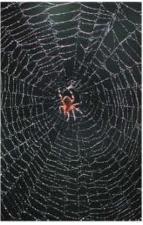Spiders are more sensitive to oscillations at higher frequencies. For example, a low-frequency oscillation at (1 mathrm{~Hz})
Question:
Spiders are more sensitive to oscillations at higher frequencies. For example, a low-frequency oscillation at \(1 \mathrm{~Hz}\) can be detected for amplitudes down to \(0.1 \mathrm{~mm}\), but a high-frequency oscillation at \(1 \mathrm{kHz}\) can be detected for amplitudes as small as \(0.1 \mu \mathrm{m}\). For these low- and high-frequency oscillations, we can say that
A. The maximum acceleration of the low-frequency oscillation is greater.
B. The maximum acceleration of the high-frequency oscillation is greater.
C. The maximum accelerations of the two oscillations are approximately equal.
In fact, spiders carefully adjust the tension of strands to "tune" their web. Suppose an insect lands and is trapped in a web. The silk of the web serves as the spring in a spring-mass system while the body of the insect is the mass. The frequency of oscillation depends on the restoring force of the web and the mass of the insect. Spiders respond more quickly to larger-and therefore more valuable-prey, which they can distinguish by the web's oscillation frequency.
Suppose a \(12 \mathrm{mg}\) fly lands in the center of a horizontal spider's web, causing the web to sag by \(3.0 \mathrm{~mm}\).
Step by Step Answer:

College Physics A Strategic Approach
ISBN: 9780321907240
3rd Edition
Authors: Randall D. Knight, Brian Jones, Stuart Field





